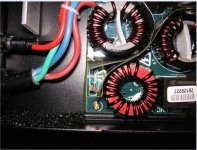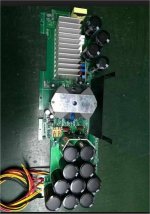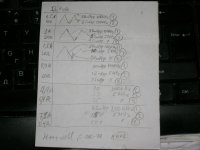You need to measure this for yourself, as I have, and also see what you get on the ac power line. The spectrum of noise frequencies is quite broad.
THx-RNMarsh
Dick,
Don't disagree, but I was talking about noise on the output power rails. Switching amplifiers without feedback assume the rails are perfect. So any rail noise goes straight into the output signal modulated by the signal level.
I think we both agree that the AC line disturbance caused by power amplifiers, even those with linear supplies, is an often neglected issue.
ES
ES,
I found them and see they even have units that are inline up to 1000 watts. I guess that could save having to get UL or other certification for the product if the power supply is external.
RNM,
Since you have so much background in power supplies how much of this broad band noise from the smps is going to get through, can't any of this be filtered out after the supply?
I found them and see they even have units that are inline up to 1000 watts. I guess that could save having to get UL or other certification for the product if the power supply is external.
RNM,
Since you have so much background in power supplies how much of this broad band noise from the smps is going to get through, can't any of this be filtered out after the supply?
OS,
I can imagine that most of the Chinese stuff on Epay is junk most of the time. Not looking to do that. I'm sure there are some truly adept at making them work on a high level but I don't know anybody in the realm. I have somewhere a smps that was inline but not enough power to run an amplifier without chocking it with a lack of power, I don't think you can find one over about 60 watt output inline so I need to have one internally. Not sure how the price of an smps compares to a large transformer and all the rest of the parts for a good power supply but I would think they could be comparable in cost. The Hypex units are damned expensive from what I looked at in the past.
The interesting thing is that Hypex uses unregulated smps, whereas typically these units are regulated.
Myself, I have experience with MeanWell as well as some wall warts for smaller speakers. Noise has never been a problem, but for sensitive circuits you need to cook it dry untill all the bad electrons have evaporated. My last design uses rc filter plus regulator followed by cap multiplier for analog xover and unfiltered output for power amps, 7 lm3886 per chanel. No noise, as in, only audible with ear stuck into the drivers.
As to cost, I think it is very competitive. The two MW smps I use deliver 360 Watts each, for a combined price of around 100 Euro's. And those are the main costs. With a sprinkling of localized decoupling caps, its done.
So, noise and price are not the problem. One potential issue is that I do see some bursts of noise, which might be related to the smps regulating. They are clearly visible on the supply rails, and can be audible as litte chirps (at very low level, ear against driver). The Hypex solution to not regulate may be the solution. After all, the noise produced by an smps is at a much higher frequency than that of a linear power supply, and hence much easier to filter out. I think linear supplies will go the same way as tube amps and record players. Nice for the fact averse niche and hobbyists.
Last edited:
I see only two issues....... the radiated emi/rfi issue which can be handled with proper shielding; and, the conducted noise on the ac power lines.... to which all your other gear is also connected.
THx-RNMarsh
The EMI radiation is not so easy to filter (I know you know ;-) but with good design it can be made negligible and not even requiring shielding. Loop control in the design is the secret.
Don't know about the mains feed-back
Jan
Using note-book-adapters to power my class-d-amps I never encountered problems with residual voltage ripple on the DC-output. I think there is quite little inside the audible frequency band. Furthermore, these chip-amps have a satisfactory power-supply rejection.
On the other hand, I got trouble specially with wall warts. These units lack PE grounding thus all the leakage current is sent to the amp as common mode disturbance.
It is true that smps produce much more audible leakage current compared to old school iron supplies. For that reason PE-grounding of primary y-caps is mandatory. Grounding the secondary circuit is imho optional.
On the other hand, I got trouble specially with wall warts. These units lack PE grounding thus all the leakage current is sent to the amp as common mode disturbance.
It is true that smps produce much more audible leakage current compared to old school iron supplies. For that reason PE-grounding of primary y-caps is mandatory. Grounding the secondary circuit is imho optional.
Don't count on that. If the PS has enough wattage to allow a fire in the product it is powering, you will still need certs. Also, put a large enough antenna on it and the emissions issues with the PS alone are not a guarantee of your product not exceeding limits.ES,
I found them and see they even have units that are inline up to 1000 watts. I guess that could save having to get UL or other certification for the product if the power supply is external.
Having said that, Mean Well is a pretty decent supplier and has been around a long time.
My last design uses rc filter plus regulator followed by cap multiplier for analog xover and unfiltered output for power amps, 7 lm3886 per chanel. No noise, as in, only audible with ear stuck into the drivers.
... and it just so happens I can vouch for that !
ES,
So the name of the company is Mean Well? I will look and see if I can find them. This will be a class ab amplifier and I take your and Esperado's recommendations to heart. When you talk spacing between the smps and the amp how much distance are we talking here? I guess a shield could be incorporated that would help with the emi/rfi between the supply and amp.
If I were needing an "anal" SMPS , some hobbyist's are cloning the Lab gruppen
SMPS in full form.
Lab G shields the entire package in the FP14000.
It looks like LabG uses multiple L/C common mode input filters/output
filters (below 1) , They seem to go way beyond the "normal" smps by
design (below 2) Ha ! An Alibaba chinese clone already !!! ...
.
Since it is being cloned , I'm sure there are variants (smaller) out there.
OS
Attachments
Many do now, but the much-marketed "pure digital" amps didn't used to have any at all. This led to amusing designs in which the power supply was a lot larger and more complex than the amplifier proper. TI had to do something about this, and privately admit that it amounts to analog feedback (oh the horrorFurthermore, these chip-amps have a satisfactory power-supply rejection.
Another consideration for switchmode amps: the single-ended ones have a huge rail-pumping effect, and the usual small output capacitors on SMPS are not going to know what to do when this occurs, unless they are expressly designed to handle it. Bridge mode is your friend here. Or, big-donkey (diyaudio doesn't like a$$) output caps. Driving stereo channels in inverse electrical polarity and restoring it at the loudspeakers will also help, to the extent that low frequencies are mixed about equally to both channels.
ES,
I found them and see they even have units that are inline up to 1000 watts. I guess that could save having to get UL or other certification for the product if the power supply is external.
RNM,
Since you have so much background in power supplies how much of this broad band noise from the smps is going to get through, can't any of this be filtered out after the supply?
yes, on the ac line side, the conducted noise freqs can be filtered, of course. you just need to measure the unwanted freqs and then design filter to remove them.
On the DC side of the supply, I would try adding a linear voltage regulator to the output of the SMPS to remove noise and be the 'filter'. One with very good PSRR.
THx-RNMarsh
I use a simple cap multiplier + zener for this purpose, and, yes, it works pretty good.On the DC side of the supply, I would try adding a linear voltage regulator to the output of the SMPS to remove noise and be the 'filter'. One with very good PSRR.
Apparently the devil is ice skating to work today. Everyone is in agreement!
One thing to add, with the little transfo used in SMPS (little capacitance between primary and secondaries coils), and the isolation of the switching electronic before-it, ground leakages are very reduced, comparing to linear PSUs.
And so the HF noise of the rectifier diodes switching in linear big supplies.
Last edited:
Steven
Try them yourself.
Meanwell SMPSs are not expensive, they are robust, reliable and because they are used all over the world in professional installations, they comply to strict specifications. Not a chip design/build (study the schematic).
Choose from their catalog
Switching Power Supply - Mean Well Switching Power Supply Manufacturer
but remember that the models with a cooling fan are energizing the fan at 40 d. Celcius internal temp and the fan airflow is noisy.
I use them for years (line level and power amp). Attached are some AC measurements of 24Vdc output with different load and amperage I did a decade ago (I have to do a decent FFT).
DC regulation is excellent. You see the stable ripple at the switching frequency (100kHz) and with heavier load you see spikes at ~5MHz increasing.
http://www.analog.com/media/en/technical-documentation/application-notes/AN-1144.pdf
Post filtering of this HF noise- if needed-should be done with LC(R) , not with a linear voltage regulator IMO.
George
Try them yourself.
Meanwell SMPSs are not expensive, they are robust, reliable and because they are used all over the world in professional installations, they comply to strict specifications. Not a chip design/build (study the schematic).
Choose from their catalog
Switching Power Supply - Mean Well Switching Power Supply Manufacturer
but remember that the models with a cooling fan are energizing the fan at 40 d. Celcius internal temp and the fan airflow is noisy.
I use them for years (line level and power amp). Attached are some AC measurements of 24Vdc output with different load and amperage I did a decade ago (I have to do a decent FFT).
DC regulation is excellent. You see the stable ripple at the switching frequency (100kHz) and with heavier load you see spikes at ~5MHz increasing.
http://www.analog.com/media/en/technical-documentation/application-notes/AN-1144.pdf
Post filtering of this HF noise- if needed-should be done with LC(R) , not with a linear voltage regulator IMO.
George
Attachments
Measure the input-output capacitance of a switcher and see if you still maintain the capacitance is small.
One thing to add, with the little transfo used in SMPS (little capacitance between primary and secondaries coils), and the isolation of the switching electronic before-it, ground leakages are very reduced, comparing to linear PSUs.
And so the HF noise of the rectifier diodes switching in linear big supplies.
Unfortunately, the desire to maximize the magnetic coupling coefficient becomes a tradeoff with minimizing the coupling capacitance. Despite the small dimensions, the coupling C is not always that small.
EDIT: for example a Mean Well switcher adapter outputting 15VDC at 1.66A measures 132pF, while a simple wall-wart transformer rated for 15VAC at 1.1A measures 30pF. The latter is less efficient and unregulated, but has the advantage of permitting short-term overloads appropriate to audio program material when used with diodes and a cap.
Last edited:
Surely we bludgeoned this to death elsewhere, to the point of conclusion that for audio risetimes and normal length cables we can safely forget TL effects and there might as as well be no such thing as mismatching......I think I have figured out what Ed is missing. As he says there is no such thing as DC and since he invokes c a full transmission line statement of the problem is necessary. We have a suddenly applied 2mV source to a T-line of unknown geometry and a mismatched load of 20k Ohms. Charging even 10pF of line capacitance to 2mV accounts for some of the femto-Coulombs of missing "charge". Where is jn when you need him.
The mistake is that we never "suddenly" apply 2mV in audio. Well, 'sudden' in audio is relatively slow in the scheme of things more to the point.
- Status
- Not open for further replies.
- Home
- Member Areas
- The Lounge
- John Curl's Blowtorch preamplifier part II


